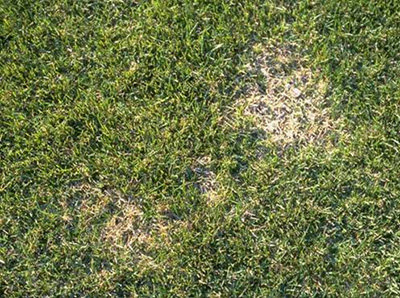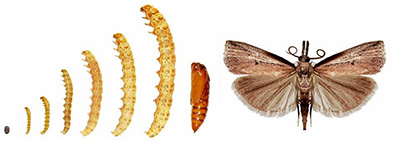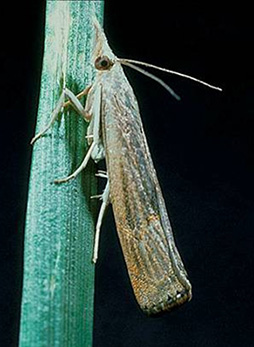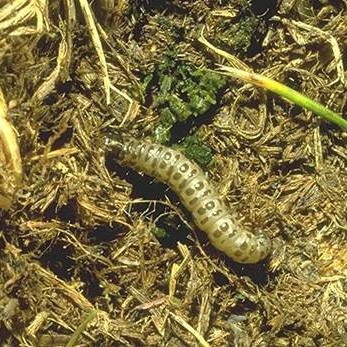
Sod webworm: Tips for your lawn
DOWNLOADMay 15, 2017 - David Smitley
Sod webworms, the caterpillar stage of lawn moths, are a pest of bluegrass lawns in Michigan. Several closely related webworm species have similar lifecycles and damage symptoms. The biology and management of bluegrass webworm, Parapediasia teterrellas (Zincken), will be discussed as a representative of the group.
Hosts
Most bluegrass species are susceptible to webworm damage, but bentgrass lawns appear to be especially vulnerable.
Damage symptoms
Damage caused by sod webworms first appears as small, brown patches of closely clipped grass. These patches may come together to form large irregular dead areas.
Similar damage
Damage to turf caused by other agents is often attributed to sod webworms. Grass killed by white grubs may be confused with webworm damage. However, grubs kill the grass roots and the areas of damaged turf can easily be pulled up like a carpet to reveal the C-shaped larvae of the white grub. Heat injury during very dry periods is also mistakenly attributed to webworm activity, especially when the grass is shallow-rooted in thatch or in clay soil.

Sod webworm damage. Photo by MSU.
Several lawn diseases cause brown patches resembling webworm injury. In these cases, check for the presence of larvae or other diagnostic characteristics. Generally, if no feeding injury or larvae are found, the problem is due to other agents and an insecticide application will not provide control.
Identification
Adults (lawn moths)
Adults are grayish tan moths, 0.5- to 0.75-inch long, with two fingerlike horns protruding from the head. Adults are generally active in the evening and have a characteristic short, zigzag flight. At rest, they fold their wings over their abdomen and appear cigar-shaped.
Larvae (webworms)
Larvae are grayish brown to dirty white with four parallel rows of dark brown spots on the abdomen. They will reach 0.75 inch long when mature.

Sod webworm life stages from egg to adult. Photo by David Shetlar, OSU.
Destructive stages
Adults do not feed; all damage is caused by larvae feeding on grass blades.
Life cycle
Nearly mature larvae (caterpillars) overwinter in the soil and resume feeding in the spring (late April-early May) as temperatures begin to rise. Occasionally, damage will occur in spring from overwintering webworms.
Adults begin to emerge in late May and early June and can be seen flying across lawns at dusk or just after dark. Adult moths rest during the day in deep grass, groundcover or in shrubbery. Females may drop up to 200 eggs in the grass while they are flying.


Sod webworm adult (left) and larva (right). Photos by MSU.
Eggs hatch in five to 10 days, and the young larvae begin feeding (skeletonizing) in the soft areas between the veins of grass blades. After a short time, the larvae become large enough to consume small portions of the grass blades and damaged leaves may appear notched. Later, the more mature larvae construct silk-lined burrows in the thatch and begin to chew grass blades off just above the thatch line and pull them into their tunnels to consume. Injury appears as small, circular (quarter-size) areas of closely clipped grass and exposed brown thatch.
Pupation occurs in late June to early July, and second generation adults are usually observed shortly afterward. New eggs are deposited and second generation larvae reach peak activity in mid- to late August. Most of the damage is caused by second generation larvae. As temperatures drop in fall, webworm larvae burrow deeper into the soil to overwinter. There are only two generations per year.
Diagnosis of webworm damage
When sod webworm injury is suspected, check the following:
- Brown patches where grass blades are missing and not simply dead.
- Green fecal pellets (frass) in the thatch.
- Webworm larvae residing in silk-lined tubes in the thatch.
Often, flocks of birds will appear on the lawn pecking small holes in the turf as they seek out the larger webworm larvae. The increased bird activity is often symptomatic of webworm presence, but is not always an accurate indication of a problem. Flocks of birds pecking at a lawn in spring may indicate the presence of white grubs.
Larvae in a lawn can be brought to the surface by drenching the infested turf with a soap solution. Mix 1 ounce of liquid dishwashing soap with 3 gallons of water. Mark off two to three sections of lawn 2-feet by 2-feet in damaged in undamaged areas. Evenly pour 1 gallon of the solution over each section. The soap irritates the larvae and they will crawl to the surface in 1 to 10 minutes. If more than four to six larvae are found in 4 square feet, treatment is advisable.
Sod webworm management
Numerous webworm adult sightings does not mean damage will occur. Harsh environmental conditions and predators often destroy many eggs and young larvae before serious damage occurs. Wait approximately two weeks after peak moth activity is observed and use a soapy water solution to check for larvae. If larvae are abundant (more than four in a 4-square-foot area), treat with an insecticide containing lambda cyhalothrin, bifenthrin, cyfluthrin or permethrin.
Using insecticides
When applying an insecticide, wear rubber gloves, long pants and rubber boots to minimize exposure. Keep leftover insecticides in the original container and out of the reach of children and pets. Mow the lawn prior to application to make sure weeds are not flowering and attracting bees as the above listed insecticides will kill bees.
See tips for other insect pests of lawns
Updated May 2017



 Print
Print Email
Email





